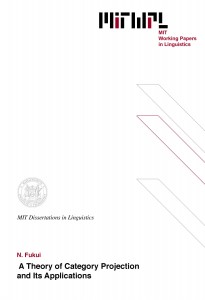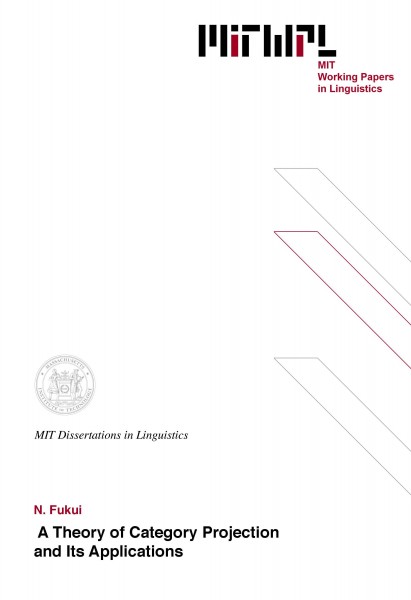A Theory of Category Projection and Its Applications
N. Fukui, 1986
This thesis proposes a new system of category projection where Lexical categories and Nonlexical (or “Functional”) categories project in different ways, which is crucially different from the standard vews in which all categories project in the same fashion.
In Chapter 1, I introduce some of the basic notions of Government-Binding Theory within which all of the discussion in this thesis takes place. The aim of Chapter 2 is to show the fundamental difference between Lexical categories and Functional categories. That is, Lexical categories have Lexical Conceptual Structures (LCS) in the sense of Hale and Keyser (1985), whereas Functional categories do not have Lexical Conceptual Structures comparable to the ones Lexical categories have, and the latter type of categories only have the function of “connecting” two syntactic units via some sort of “binding” (and/or “c-selection”) and “agreement.” Based on this fundamental difference, a new projection system is introduced, in which Lexical categories project up to a single-bar level, allowing free recursion at that level, while Functional categories can project up to a double-bar level, taking a unique specifier and a unique complement.
Chapter 3 explores various consequences of the projection system introduced in Chapter 2. One important consequence is that the proposed projection system, combined with a “bottom-up” q–marking mechanism, predicts that the so-called “external argument” appears within the projection of a Lexical head at D-structure, receiving the external q–role in that position, and then moves outside the Lexical projection to its S-structure position, for Case reasons. This move makes possible the explicit syntactic representation of what has been called the “implicit argument” both in noun phrases and in clauses (in the case of passives).
In Chapter 4, I proceed to focus on Japanese and propose a new phrase structural configuration for this language in the light of the projection system introduced in Chapter 2. It is argues that Japanese lacks the Functional categories DET and COMP, and has a very defective INFL which contains no agreement features. From this, it immediately follows that Japanese has no specifiers, which close off the category projection. I argue there that this is indeed the case, i.e., Japanese has no specifiers and every phrase in this language is always “open.” Other consequences of my proposal, including the derivability of the lack of overt wh-movment in Japanese, are also discussed in this chapter.
Thesis Supervisor: Kenneth Hale
Title: Ferrari P. Ward Professor of Linguistics
Table of Contents
Chapter 1 Introduction 11
1.1 Basic Notions 12
1.2 Outline of the thesis 21
Notes to Chapter 1 25
Chapter 2 Projection Types: Lexical vs. Functional Categories 26
2.1 Introductory remarks 27
2.2 The structure of IP and DP 50
2.3 Function features 53
2.4 The saturation principle 56
2.5 Deriving the surface order 60
2.6 On the specifier position 65
Notes to Chapter 2 86
Chapter 3 Consequences of the Projection System 95
3.1 The simplification of q-marking 96
3.2 The position of PRO 113
3.3 The notion of maximal projectin and the status of the X-bar
schema 162
Notes to Chapter 3 169
Chapter 4 The Phrase Structure of Japanese 182
4.1 Facts to be accounted for 185
4.1.1 Evidence for the “VP” node 185
4.1.1.1 Evidence from the Binding Theory 185
4.1.1.2 Evidence from crossover 188
4.1.1.3 Evidence from the distribution of PROarb 193
4.1.2 Evidence against the “VP” node 195
4.1.2.1 Evidence from VP movement rules 195
4.1.2.2 Evidence from the distribution of adverbial
elements 196
4.1.2.3 Evidence from empty pronominals 199
4.2 Japanese as a SPECless language 201
4.2.1 Functional categories in Japanese 202
4.2.1.1 D 202
4.2.1.2 I 207
4.2.1.3 C 217
4.2.2 “Specifiers” in Japanese 228
4.2.2.1 Noun phrases 230
4.2.2.2 Sentences 236
4.2.3 Summary 243
4.3 The phrase structure of Japanese 244
4.3.1 The phrase structure of Japanese: a proposal 244
4.3.2 Facts recapitulated 248
4.3.2.1 Evidence for the “VP” node 248
4.3.2.2 VP movement 250
4.3.2.3 The distribution of adverbial elements 253
4.3.2.4 Empty pronominals 257
4.4 Some consequences 261
Notes to Chapter 4 270

